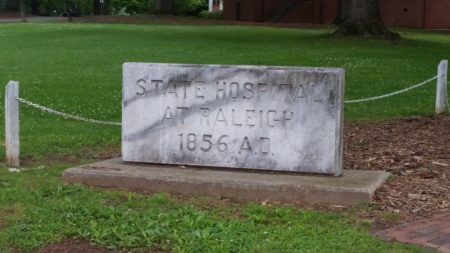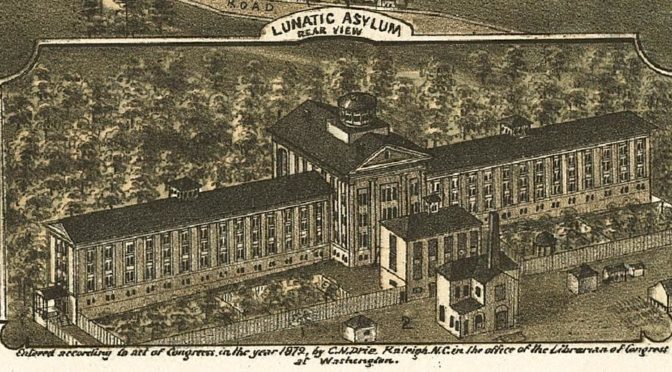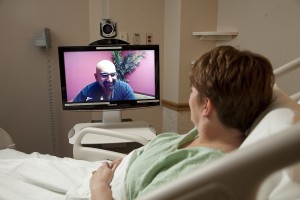More than a hundred people gathered Sunday afternoon to reflect and discuss what should be part of a memorial to the now-shuttered mental health facility.
By Thomas Goldsmith
Dorothea Dix, the former state mental hospital in Raleigh, once formed a community where patients and professionals left the grounds together to attend plays at Memorial Auditorium, spend weekends at the beach, and go to football games at Carolina and Duke.
It was a place where one huge dining hall served meals and the other was used for bake sales, as a “treatment mall,” as well as talent shows with remarkable performances by patients.

And it was a treatment center where eight people sometimes were required to hold down an anesthetized patient during electroconvulsive shock therapy.
These memories of decades past, some chilling and some charming, emerged Sunday as scores of people with connections to Dorothea Dix Hospital began to lay plans for its remembrance.
Former patients, volunteers, professionals and historians, they gathered at N.C. State University’s Talley Student Union to take part in the North Carolina Health News project, Lives on the Hill. The ongoing effort seeks to spur discussion on how the hospital should be memorialized in the new park planned for more than 300 acres of the west Raleigh site.
Click here to see an interactive timeilne on the history of Dix hospital.
“Thanks to Dix, and thanks to all the processes I went through and the work that I did, I can talk to people, I have a voice,” former patient Eloise Brinson said in one of several videotaped oral histories presented Sunday.
The table for an afternoon of shared memories was set with presentations by:
• Mebane Rash, editor-in-chief at the nonprofit Education NC, who spoke on the history of Dorothea Dix and mental-health reform in North Carolina. “The lives lived on this hill can and should inform public policy in the 21st century,” Rash told the gathering.
• Fitzhugh Brundage, professor of history at the University of North Carolina at Chapel Hill, who used examples of the state’s war memorials to address the day’s central question: “How do we connect the past to the future?”
• Jon Crispin, the Massachusetts photographer who discussed and showed images from “The Willard Suitcases.” His project depicts belongings left behind by decades of residents at the Willard Asylum for the Chronic Insane in New York State.

“The connection between the staff and the patients were the main reason these cases weren’t thrown away,” Crispin said, noting that staff were too attached to the patients to throw away their belongings once they died. “In many cases, families declined to come and pick up the cases or pay for shipping.”
Care through generations
At Dix, those connected to the hospital said Sunday, the community worked together like family, sometimes literally and at other times figuratively. Generations of staff lived in houses on the grounds, and patients and professionals worked together for decades at times.
“It was teamwork and it was a big family,” said John Myhre, pharmacist at Dix from 1972 until 2009.
Myhre, who had been interviewed by NC Health News’ team of videographers, also attended Sunday’s event. Before the presentations, he said an account of Dix’s legacy should include the research carried out there on a variety of medications including lithium. Trials were performed by drug companies and included informed consent on the part of participants, he said.
Major changes in medication practice for people with mental illness also took place during the latter years of the 20th century.
“When I first started they were giving monster doses of thorazine,” a powerful antipsychotic drug, Myhre said. “A drugstore dose would be 25-50 milligrams four times a day. I saw lots of doses of 5,000 milligrams.”
“I was crushed”
The video interviews, portions of which were shown during Sunday’s event, gave a broad range of opinions and facts about what informants had experienced at the hospital.
Brinson, a former patient, recounted being disappointed when the hospital was closed.
“Dorothea Dix should have been developed as a community for the mentally ill,” she said. “People could have gone out into the community and worked and come home [to Dix].”
Margaret Raynor, a former psychiatric nurse at Dix, said during her employment, the state of North Carolina reversed direction on the hospital that had served so many people.
“I was crushed,” she said. “I will tell you that the person who was head of DHHS had come and told us they were going to build a new Dix.”





